By Prateek Viswanathan* and Thomas Ritchie –
By creating the new precedential Fintiv factors, the PTAB provides guidance on what it will consider when deciding whether to deny institution of an IPR petition challenging patent claims that are also being litigated in a parallel proceeding.
The PTAB may not authorize the institution of an IPR unless it determines that the information in the petition and any response “show that there is a reasonable likelihood that the petitioner would prevail with respect to at least 1 of the claims challenged in the petition.” 35 U.S.C. § 314(a). But the PTAB has determined that it has discretion to deny an IPR even when there is such a “reasonable likelihood,” according to seven non-exhaustive factors set out in General Plastic. General Plastic Industrial Co., Ltd. v. Canon Kabushiki Kaisha, IPR2016-01357, Paper 19, § II.B.4.i (PTAB Sept. 6, 2017) (precedential).
The PTAB has also determined it may deny an IPR when the patent at issue is litigated in a parallel proceeding. NHK Spring Co., LTD., v. Intri-plex Technologics, Inc., IPR2018-00752, at 20. And after the precedential decision in Apple v. Fintiv, the PTAB has identified six factors it will consider when exercising that discretion to deny in IPR in view of a parallel proceeding. Apple v. Fintiv, IPR2020-00019, Paper 11 (PTAB Mar. 20, 2020) (precedential).
- The first factor that the PTAB considers is whether the court granted a stay or whether evidence exists that one may be granted if an IPR is instituted. If the district court issued a stay of the proceedings pending resolution of the PTAB trial, this factor strongly weighs against exercising discretion to deny institution. If the district court dismissed a motion of stay without prejudice, then the PTAB looks to whether the court indicated to the party that “it will consider a renewed motion or reconsider a motion to stay if a PTAB trial is instituted.” Id., at 8. If there is any such indication, this fact usually weighs against denying institution. This analysis also applies if the patent is at issue in an ITC investigation. Id., at 8.
- The second factor that the PTAB considers is the proximity of the court’s trial date to the projected statutory deadline for the PTAB’s final written decision. If the district court’s trial date is earlier than the projected statutory deadline, then this factor weighs in favor of exercising discretion to deny institution. If the trial date is close to or after the statutory deadline, then this factor is more neutral; the PTAB states that this will “likely implicate” the other five factors. Id., at 9.
- The third factor that the PTAB considers is the investment in the parallel proceeding by the court and the parties. If the court issued substantive orders related to the patent at issue, including claim construction orders, this factor weighs in favor of exercising discretion to deny institution. Absent such orders, this factor weighs against exercising discretion to deny institution. Id., at 9–10. But even if the court did issue substantive orders, if the petitioner promptly filed its petition after learning which claims were being asserted in the parallel proceeding, this factor may weigh against exercising discretion to deny institution. Id., at 11.
- The fourth factor that the PTAB considers is the overlap between issues raised in the petition and in the parallel proceeding. If the petition raises the same or substantially the same claims, grounds, arguments, or evidence as presented in the parallel proceeding, this factor weighs in favor of exercising discretion to deny institution. Id., at 12–13. But if the petition includes materially different grounds, arguments, or evidence than those in the district court, this factor weighs against exercising discretion to deny institution. Id.
- The fifth factor that the PTAB considers is whether the petitioner and the defendant in the parallel proceeding are the same party. If the petitioner is not the defendant in the parallel proceeding, then this factor weighs against exercising discretion to deny institution, unless the issues are the same or substantially similar to those in the parallel proceeding. Id., at 13–14.
- The sixth factor that PTAB considers is whether other circumstances impact the PTAB’s exercise of discretion, including the merits. Other factors and circumstances may affect the PTAB’s discretion to deny institution, including the merits of the grounds raised in the petition. Other examples include: filing of serial petitions, parallel petitions challenging the same patent, and considerations implicated by 35 U.S.C. § 325(d). Id., at 14–16.
In evaluating the Fintiv factors, no single factor is likely to be dispositive. Instead, the PTAB “takes a holistic view of whether efficiency and integrity of the system are best served by denying or instituting review.” Id., at 6.
* Prateek Viswanathan is a 2020 Summer Associate in Jones Day’s Chicago office.

